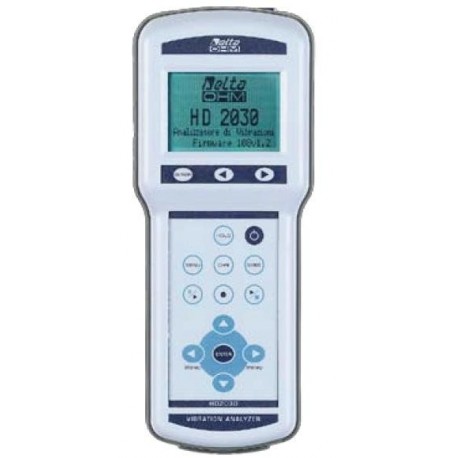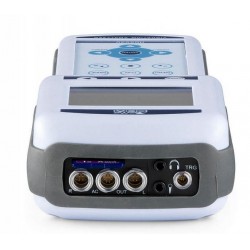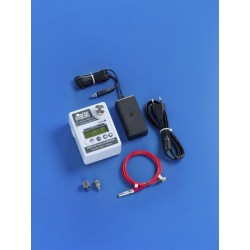No products
Prices are tax excluded
Product successfully added to your shopping cart
There are 0 items in your cart. There is 1 item in your cart.
HD2030 Four channel vibrations analyzer
HD2030
New
- Consulta este producto
- Remove this product from my favorite's list.
- Add this product to my list of favorites.
| Number of Channels | 4 channels |
| Type of Instrument | Vibration Analyzer |
| The instrument measures: | Hand-arm vibrations |
4-channel vibration analyzer kit for IEPE accelerometers
- Measurement of the vibrations transmitted to the hand-arm system and to the whole body with Fa, Fc, and Fz band‑pass filters and Wb, Wc, Wd, We, Wj, Wk, Wh, Wj, Wk, Wm filters compliant with ISO 8041, ISO 5349 and ISO 2361 requirements.
- Data logging functions with 8 MB memory and SD card.
- Octave bands from 0.5 Hz to 2 kHz and third octave bands from 0.3 Hz to 3.2 kHz real time spectral analysis of the acceleration according to IEC 61260 with velocity and displacement calculation (“Spectral analysis” option).
- Statistical analysis with probability distribution graph, calculation and graphical display of the percentile levels from L1 to L99 (“Statistical analysis” option).
- Digital recording of the accelerometer signals (“Digital recording” option) Recording of vocal comments associated to the measurements.
- Measurement range 110 dB, linear range 80 dB.
- RS232 and USB serial interface.
One tri-axial and one mono‑axial accelerometer or up to four mono-axial accelerometers can be connected to the analyzer.
HD2030 is compliant with ISO 8041, ISO 2631, ISO 5349 and IEC 61260 normatives.
The accelerometers, the connection cables and the adapters ARE NOT included in the kit.
The HD2030 is a portable vibration analyzer that will conduct spectral and statistical analysis simultaneously on four channels.
It measures current parameters that are required to protect workers from any sort of vibration related risks.
It measures vibrations that are affecting the hands and the entire body. The HD2030 is easy to use and has a welcome operation flexibility.
The noise and vibration program supplied by the studio with the instrument can update the firmware.
The HD2030 complies with ISO standards 8041:2005, ISO 5349-1:2001 (handarm vibrations) and ISO 2631-1, 2 and 4 1997 (whole-body vibrations).
It has octave and third octave filters to meet IEC 61260 class 1 specifications.
The vibration analyzer detects accelerations through two accelerometers and has IEPE electronics.
The HD2030 portable vibration analyzer. The HD2030 can perform spectrum analysis and statistics together. The instrument supplies all the measurement parameters required by the regulation in force with reference to the protections of the workers against the risk connected to vibrations and can measure the vibrations transmitted to the hand-arm system and to the entire body.
Features:
The instrument was designed combining ease of use with maximum flexibility and the ability to adapt the instrument to evolving vibration laws. The user can directly update the firmware using the supplied Noise & Vibration Studio program.
The HD2030 complies with the specifications of the regulation ISO 8041 of 2005 and ISO 5349-1 of 2001 (vibrations transmitted to the hand-arm system) and ISO 2631-1,2 and 4 of 1997 (vibrations transmitted to the whole body). The octave and third octave filters meet the class 1 specific of the IEC 61260 regulation.
The HD2030 Vibration Analyzer detects accelerations on four axes through two accelerometers with integrated amplification electronics (IEPE or similar). Three axes are grouped at the right entrance, where you can connect three accelerometers or an accelerometer of a triaxial type; the fourth axis is associated with the left input. Using accelerometers with built-in electronics that can make low-impedance, low-noise connections between the accelerometer and the instrument, simplifies use and reduces the likelihood of erroneous or misleading measurements against interference or electromagnetic disturbances.The HD2030 analyzes the signal provided by accelerometers and performs calculations simultaneously on all four axes. The instrument calculates, in parallel for all channels, the values of the weighted acceleration and the spectra for the octave or third octave band, showing the acceleration, speed or displacement for each frequency band. Frequency weights can be freely chosen based on the specific application. Along with the average and instantaneous acceleration values, the analyzer also produces peak levels, vibration dose (VDV), crest factors, and also performs statistical analysis. As a statistical analyzer, the HD2030 calculates the probability distribution of a measurement parameter and analyzes it according to 1dB classes. The probability distribution graph and one with the percentile levels from L1 to L99 are available. Acquisition of acceleration in 4 channels allows, for example, to analyze vibrations.
HD2030 technical features:
• Technical regulations: ISO 8041 of 2005 ISO 5349-1 of 2001 (vibrations transmitted to the hand-arm system) ISO 2631-1,2 and 4 of 1997 (vibrations transmitted to the whole body). regulation IEC 61260 of 1995 class 1
• Measurement mode: Vibrations transmitted to the hand-arm system Vibrations transmitted to the whole body Vibrations in buildings
• Measurement parameters: RMS, VDV, MTVV, Peak, Max., Min.
• Frequency weights Fz, Fc and Wh for measurements on the hand-arm system Fz, Fa, Wb, Wc, Wd, We, Wj, Wk for whole body measurements Fz, Fm and Wm to measure transmitted vibrations by the buildings
• Spectrum analysis for octave band and third octave band. The center frequency range depends on the selected application according to what is indicated in the following table.
.jpg)
The HD2030 analyzer can perform all the measurements required by legislation regarding the protection of workers against the risk of exposure to mechanical vibrations (Decree Law 19 August 2005 No. 187).
Selecting to perform hand-arm (HA) or whole body (WB and BV) measurements changes the extent according to the frequency of the spectrum analysis.
For hand-arm measurements, the field extends from 3.15Hz to 3.15kHz (from 4Hz to 2kHz for spectrum for octave bands), while for whole-body measurements, the field of center frequencies is toward frequencies. low, from 0.315Hz to 315Hz (from 0.5Hz to 250Hz for spectrum for octave bands).
The HD2030 is suitable for assessing worker exposure to vibrations and risk of injury in the following cases:
• vibrations transmitted to the hand-arm system through vibrating tools or objects subject to vibrations or impacts or vibrations transmitted to the whole body through the driver's seat or vibrations transmitted to the whole body at work stations;
• vibrations transmitted to the whole body by buildings subject to vibrations or impacts. The HD2030 is a vibration analyzer suitable for the following applications:
• spectrum analysis of vibrations for octave or third octave bands,
• statistical analysis with calculation of the percentile levels from da L1 to L99, evaluation of the attenuation of vibrations of anti-vibration gloves, seats and materials or structural tests in buildings.
The kit includes:
· HD2030: 4-axis vibration analyzer complete with datalogging and storing of vocal comments.
· HD6188: Silicone grease.
· HD6273: Wax tray for accelerometers gluing.
· 080A90: Glue for quick fixing.
· HD2030MC: 32 GB SD memory card.
· CP22: USB serial cable for PC connection. Alternatively it can be supplied on request the HD2110CSNM cable for RS232 (COM
type) serial ports.
· “Noise Studio” software for PC with Windows® operating systems downloadable from Delta OHM website.
· User manual and carrying case.
· ISO 9001 calibration reports for HD2030 vibration analyzer: calibration as vibration meter according to ISO 8041
NOTE: The accelerometers, the connection cables and the adapters ARE NOT included in the kit.








